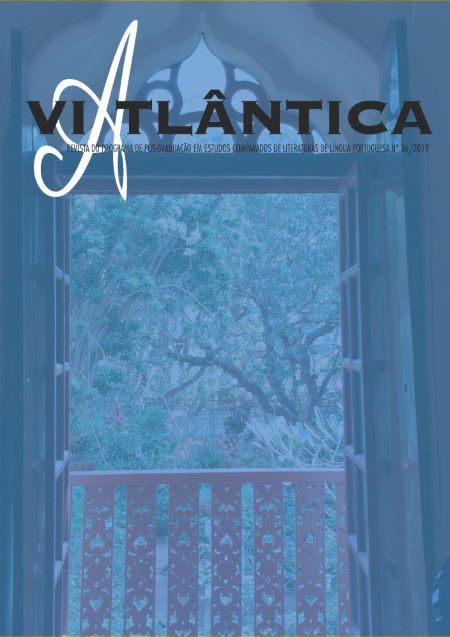THE LITERARY MOVEMENT CYBERPUNK: THE AESTHETICS OF A DECLINING SOCIETY
DOI:
https://doi.org/10.11606/va.v0i36.155102Keywords:
fantastic literature, science fiction, cyberpunkAbstract
This essay focuses the cyberpunk literary movement. It proposes a reflection on how the authors of this subgenre of science fiction treated aesthetically the expectations of social transformations in the face of the emergence of new communication technologies in the 1980s. It seeks to identify how the movement felt and represented social issues and tensions in relation to a future increasingly marked by a technological imperative and by contemporary capitalism. This approach starts contextualizing the object, to analyze the transformations of paradigms that occurred throughout the existence of the literary movement until its saturation and its unfolding in the so-called post-cyberpunk literature.
Downloads
References
BETHKE, Bruce. Cyberpunk. Amazing Science Fiction Stories, v. 57, n. 4, Nov 1983. Disponível em < https://goo.gl/e6845e >. Acesso em 18 jan. 2019.
BREDEHOFT, Thomas. The Gibson Continuum: Cyberspace and Gibson's Mervyn Kihn Stories. Science Fiction Studies. v. 22, n. 2, pp. 252-263, 1995.
BRODERICK, Damien. Reading by Starlight: Postmodern Science Fiction. London: Routledge, 1995.
BUKATMAN, Scott. Terminal Identity. The virtual subject in post-modern science fiction. 4 ed. Durham: Duke Universtiy Press, 1998.
CHKLOVISKI, V. A arte como procedimento. In: TODOROV, T. (Org.) Teoria da Literatura. Formalistas russos. Porto Alegre: Globo, 1971, p. 39-56.
CLUTE, John; NICHOLLS, Peter. Encyclopedia of Science Fiction. Londres: Orbit, 1993.
DELANY, Samuel. Silent Interviews on Language, Race, Sex, Science Fiction, and Some Comics: a Collection of Written Interviews. Hanover, NH e Londres: Wesleyan University Press, 1994.
DICK, Philip K. Minority Report - A nova lei. Rio de Janeiro: Record, 2002 (Original de 1956).
DOZOIS, Gardner. Science Fiction in the Eighties. Washington Post, 30 de dez de 1984. Disponível em < https://goo.gl/2bLvBY>. Acesso em: 18 jan 2019.
FREEDMAN, Carl. Critical Theory and Science Fiction. Middletown: Wesleyan University Press, 2000.
GIBSON, William. Neuromancer. São Paulo: Aleph, 2016. 320p.
GIBSON, William. Count Zero. São Paulo: Aleph, 2017a. 312p.
GIBSON, William. Mona Lisa Overdrive. (eBook Kindle) São Paulo: Aleph, 2017b. 320p.
GROSSMAN, Lev; LACAYO, Richard. Neuromancer (1984). TIME Magazine All-Time 100 Novels. Time (October 16), 2005.
HARVEY, David. Condição Pós-Moderna. São Paulo: Edições Loyola, 2004 (original de 1989).
HARAWAY, Donna J. Manifestly Haraway, University of Minnesota Press: ProQuest Ebook Central, 2016.
KLAPCSIK, Sandor. Liminality in Fantastic Fiction: A Poststructuralist Approach. Jefferson (North Caroline); London: McFarland & Company, 2012.
LEMOS, André. Ficção científica cyberpunk: o imaginário da cibercultura. Conexão – Comunicação e Cultura, UCS, Caxias do Sul, v. 3, n. 6, p. 9-16, 2004.
LÉVY, Pierre. Cibercultura. (Trad. Carlos Irineu da Costa). Coleção TRANS. São Paulo: Ed. 34, 1999. (original de 1997).
LÖWY, Michael, SAYRE, Robert. Revolta e melancolia: o romantismo na contramão da modernidade. Petrópolis: Vozes, 1995.
LYOTARD, Jean-François. A Condição Pós-Moderna. Rio de Janeiro: José Olympio, 1998. (original de 1979)
MILLER, Henry. Pesadelo Refrigerado. São Paulo: Francis, 2006. (Original de 1945).
MORGAN, Richard. Carbono Alterado. Rio de Janeiro: Bertrand Brasil, 2017.
NEVINS, Jess. Introduction: The 19th-Century Roots of Steampunk In: VANDERMEER, Ann; VANDERMEER, Jeff. Steampunk. San Francisco: Tachyon Publications, 2008, p. 3-11.
PERSON, Lawrence. Notes Toward a Postcyberpunk Manifesto. Nova Express, v.4, n.4, 1998. Disponível em: <https://goo.gl/hkxYZ3> . Acesso em: 19 fev 2019.
RABKIN, Eric. The fantastic in literature. New Jersey: Princetown University Press, 1976.
SANDNER, David. Fantastic Literature: A Critical Reader. Westport, Connecticut, London: PRAEGER, 2004.
SCALZI, John. Encarcerados. São Paulo: Editora Aleph, 2018. (eBook Kindle).
STEPHENSON, Neal. Snow Crash. São Paulo: Editora Aleph, 2015. (eBook Kindle)
SUVIN, Darko. Positions and Suppositions in Science Fiction. Londres: Macmillan, 1988.
THOMAS, Louis Vincent. Anthropologie des obsessions. Paris: L’Harmattan, 1988.
TODOROV, Tzvetan. Introdução à Literatura fantástica. São Paulo: Editora Perspectiva, 1981.
VANDERMEER, Ann; VANDERMEER, Jeff. Preface. In: Steampunk. San Francisco: Tachyon Publications, 2008.
Downloads
Published
Issue
Section
License
Copyright (c) 2019 Glaucio Aranha

This work is licensed under a Creative Commons Attribution-NonCommercial-NoDerivatives 4.0 International License.
Authors who publish with this journal agree to the following terms:
- Authors retain copyright and grant the journal right of first publication with the work simultaneously licensed under a Creative Commons Attribution License that allows others to share the work with an acknowledgement of the work's authorship and initial publication in this journal.
- Authors are able to enter into separate, additional contractual arrangements for the non-exclusive distribution of the journal's published version of the work (e.g., post it to an institutional repository or publish it in a book), with an acknowledgement of its initial publication in this journal.
- Authors are permitted and encouraged to post their work online (e.g., in institutional repositories or on their website) prior to and during the submission process, as it can lead to productive exchanges, as well as earlier and greater citation of published work (See The Effect of Open Access).






















